Organization
Episode #8 of the course Ten key skills for career advancement by Patricia Haddock
Yesterday, you learned how to maximize your time to get the results you need. But time management isn’t enough. It goes together with today’s lesson: Organization. It’s hard to have one without the other.
If you have a messy desk, stacks of paper on the floor, and lots of knick-knacks around your space, others will perceive you as disorganized, and when something hits the fan, the finger will all point to you even if you are highly organized and know where everything is. Some people are naturally highly organized. Everything has a place and is kept in its place. Other people are “out-of-sight, out-of-mind” people. If it’s not in front of them, they forget about it. If you’re organizationally challenged, take heart. You can impose order and still be kind to your need to have everything in front of you, so you don’t forget anything.
Organization Needs a Filing System
A physical filing cabinet contains labeled folders that hold a wide variety of paper documents, including sub-folders. Your electronic devices—computer, laptop, tablet, and smartphone—are no different, except they contain apps and digital downloads. This means that you can organize them just as you would a filing cabinet in the corner of your office.
You do this by moving individual apps into labeled folders and then organizing the folders into a logical system. Keep in mind, the apps you use several times a day and those that make you most productive should be on your home screen where you can access them immediately.
Filing labels should make it easy to retrieve them. If you can think of several names for your files and may not remember the one that you used for a specific document, you want to use broad categories for labeling, such as All Insurance, All Health Records, All Tax Records, and so on. Within these broad categories, you can create sub-labels, such as Home Insurance, Auto Insurance, Dental Insurance, and so on. Use the same labeling system for ALL files, electronic, email, and paper across all devices.
Organize Your Workspace
Whether your space is an office, cubicle, or shared work area, you want to create and maintain organization and order.
Physical work area:
• Keep on your desktop what you need daily and what you are working on at the moment.
• Keep personal photos, knickknacks, extra pens, pencils, and clips to a minimum.
• Do not stack files on your desk.
• Files and supplies not used every day and items that you refer to often, but that are not necessary to meet your primary responsibilities, should be filed in cabinets or placed away from your primary work area.
• Books, manuals, and anything that can be stored upright needs to go in bookcases.
Electronic desktop:
• The files and applications you use every day should be easily accessible.
• Documents should be filed in a folder, not loose on the desktop.
• Use shortcuts and aliases to quickly find files, software, applications, and websites you use frequently.
• Maximize your portable devices, so you can easily, quickly access anything you need.
Clear Clutter and Stay Clutter-Free
Eliminate “clutter” boxes and “miscellaneous” piles. Everything needs a place and a label. Set aside 15 minutes a day to file anything that is not in an assigned place. If you have large piles of clutter to tackle, clear one pile a week until the clutter is gone. Do not forget the stuff you have piled on windowsills and under the furniture. Some people have such large piles, they clear by the inch.
Facing a jam-packed inbox every day can make you feel irritable and tired before you begin the day. Remember, your email inbox is like a filing cabinet, and your files should have the same labeling and filling system you use elsewhere. File emails as soon as you complete them.
“Clutter is nothing more than postponed decisions.” —Barbara Hemphill
Action Steps to Improve and Showcase Your Organization Skills
• Is your work area neat and organized? If not, begin the process of organizing it.
• Keep knick-knacks and personal items to a minimum.
• Create and use a filing system or review your existing one to see if it needs to be improved.
• File both paper and electronic documents daily to avoid adding clutter.
• Be able to find any document—paper or electronic—within minutes.
Tomorrow, you learn how to improve your ability to set and realize goals and apply this knowledge to achieve your career goals.
Patricia
Recommended video
7 Things Organized People Do That You (Probably) Don’t Do by Thomas Frank
Recommended books
Share with friends

